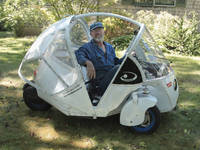The Microcar Concept From 100MPG Moonbeam Builder
SEE ALSO: Jory Squibb's Website
Editors Note: I recieved an email from TACH viewer Squibb who thought that his MicroCar project and building plans will be of interest to many of you out there, I agreed and here is the entry point into the world of 100MPG plus cars... enjoy and let me know what you think...msnide@theautochannel.com.
By Jory Squibb
The concept of a 'microcar' is that of building an enclosed automobile on a very small and light scale. This often means using motorcycle and motorscooter components.
You might think this concept is new, so look at the website microcarmuseum.com How I poured over that website, studying every car. When I got to the 1977 Arola, I lingered: This is it! The very car I wanted to build.
Obviously, my thinking then moved on, more in the Messerschmitt direction. But there's a goldmine of ideas here. After WW2 in Europe, when people were so poor, cyclecars appeared everywhere. Messerschmitt, banned from making airplanes, produced one, as did Isetta, and many British, French, and Italian companies.
A microcar is not fully a car. It's a sort of half-car, which fits into your life as an addition to another car, or to public transportation, which will meet your long-range and high speed travel needs.
This limitation of a microcar gives it a bad rap. We immediately compare it to a multi-purpose full size car in terms of highway performance, passenger capacity and comfort, etc. , and then don't take it seriously. In this respect, a microcar is similar to an electric car. It does a limited job more ecologically than a normal car. As the concept evolved in my mind, I knew I wanted a car which was peppy up to 40 MPH, so I had to go beyond my beloved mopeds.
I've driven antique cars for years, and believe me it's a drag to hold up traffic. I knew I needed heat in the cab--lots of it--or the car would sit idle in the winter, which is long here in Maine. And, I love love love motorcycles, but have "aged-out" of driving them after my third accident 2 years ago. Here was a way to continue working with those beloved machines, and continue to drive them safely and year-round.
Well, driving Moonbeam with its belt drive and unexciting sounding engine, doesn't quite hit the motorcycling nail on the head, but...
But let's get back to the concept: If you were Martians, newly landed on Earth, you might exclaim: " Hey, these guys have a great source of energy! It's concentrated, easy to use, and available everywhere! They call it gasoline."
The problem with gas is that it's always been so cheap, we've learned to use it extravagantly. To move our 150 pound bodies, we hurtle 3000 pound boxes through space at needless speeds and acceleration. But cut that box to one tenth the weight, cut that engine to one tenth the horsepower, and the result is increased efficiency by a factor or four or five. And the irony is you don't have to be that humble.
Driving Moonbeam, you feel you are in such a peppy agile thing, not a sluggard at all. Let me take you through driving it. You walk up to Moonbeam, which comes up to your chin. You grab the handle on the roof and slide it back.
Its counterbalanced so that's easy. You grab the central roll bar and step in. The first time you do it, it's strange, but by the second time it's easy. If it's pouring rain, you do this quickly because the interior is getting wet, unlike a side entrance. Then you slide the canopy closed and snap it locked. Otherwise, it will shift going over bumps. You buckle up and try to figure what to do with your long legs. Anyone over 5'10" usually crosses them.
Most Moonbeam builders will probably move the steering arms further ahead of the driver, and also add a few inches of leg room. You turn the ignition switch on, hearing the heater motor, which always runs, hum. You touch the starter switch on the right handlebar with the thumb.
The engine starts with a loud, tinny sound. (more engineering work ahead, here). You squeeze the left brake caliper which releases with a click. This is the rear and emergency brake. You check the rear view mirrors, click the left turn signal, twist the right hand grip and move out into the road, cancelling the turn signal manually.
All your bicycling instincts transfer. The panic response of grabbing the brakes is the the same except that right brake is now front, not rear. This is good, because especially in a three wheeler, the lion's share of braking is done by the two front wheels. So I guess you can hear my fascination with the microcar.
I plan to drive this one for years in all seasons. The fuel cost is about 2.5 to 3 cents a mile. It's hard to be inspired to convert to bio-diesel, electricity, or natural gas with an operating cost that low. I do hope to quiet the thing down....



